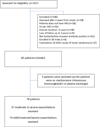Exacerbation Rate in Generalized Myasthenia Gravis and Its Predictors
- PMID: 33321491
- PMCID: PMC7969373
- DOI: 10.1159/000512077
Exacerbation Rate in Generalized Myasthenia Gravis and Its Predictors
Abstract
Objective: The aim of the study was to estimate the exacerbation incidence rate (IR) in acetylcholine receptor antibody (AChR)-positive generalized myasthenia gravis (MG) and its predictors.
Methods: The primary outcome in this retrospective study was to estimate moderate-to-severe (M-S) exacerbations IR in the early course of generalized MG. The secondary outcome was to explore the predictors of MG exacerbations.
Results: Between 1999 and 2015, we identified 78 AChR-positive generalized MG patients and 37 M-S exacerbations over the first 6 years following the onset of generalized MG symptoms. The M-S exacerbation IR was 12.2 per 100 person years (95% confidence interval [CI] 8.8-16.8). Any exacerbation (including mild) IR was 24.4 per 100 person years (95% CI 19.4-30.7). After controlling for confounding factors, MG exacerbation IR predictors included gender, disease severity at onset, and prednisone dose reduction with risk ratio of 0.34 (male gender), 2.67, and 20.8, respectively (all p values <0.05). M-S exacerbation occurred in 25 cases (32.1%), while any exacerbation (mild or M-S) was detected in 45 cases (57.7%).
Conclusion: More than half of newly diagnosed AChR + MG cases experience an exacerbation in the first 6 years. Gender, disease severity at onset and prednisone dose reduction are predictors that could inform clinical practice and future research.
Keywords: Exacerbation; Immunosuppressant; Incidence; Myasthenia gravis; Predictors; Prednisone.
© 2020 S. Karger AG, Basel.
Figures
References
-
- Baggi F, Andreetta F, Maggi L, Confalonieri P, Morandi L, Salerno F, et al. Complete stable remission and autoantibody specificity in myasthenia gravis. Neurology. 2013;80(2):188–95. - PubMed
-
- Dicker RC, Coronado F, Koo D, Parrish RG. Principles of Epidemiology in Public Health Practice, 3rd Edition. Measures of Risk. 2006:3–13.
Publication types
MeSH terms
Substances
Grants and funding
LinkOut - more resources
Full Text Sources
Medical


